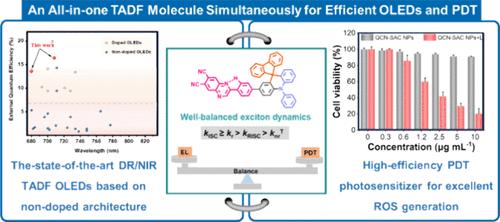多功能热激活延迟荧光材料,可实现光动力治疗和深红色/近红外电致发光的高效率
IF 16
1区 材料科学
Q1 CHEMISTRY, MULTIDISCIPLINARY
引用次数: 0
摘要
热激活延迟荧光(TADF)材料越来越受到有机电子学及其相关领域的关注,如生物应用和光催化剂。然而,对于TADF发射器来说,在多种应用中展示其多功能性和高性能仍然是一项具有挑战性的任务。在这里,我们首先通过策略性地操纵激子动力学,提出了这样一种概念验证的TADF材料,即QCN-SAC。一方面,QCN-SAC表现出明显的聚集体致深红/近红外辐射,辐射率高于107 s-1,在无氧条件下激子利用率接近100%。在基于qcn - sac的非掺杂有机发光二极管(OLED)中,可以在708 nm处达到16.4%的优异外量子效率。另一方面,在不利用重原子效应的情况下,QCN-SAC还表现出超过108 s-1的高系统间交叉速率,这使得基于QCN-SAC的纳米颗粒在促进成像引导光动力治疗(PDT)中活性氧的产生方面表现良好。这项工作提出了设计用于OLED和PDT应用的高性能一体化TADF分子的基本原理。这一发现有望在不久的将来推进具有广泛用途的多用途TADF材料的开发。本文章由计算机程序翻译,如有差异,请以英文原文为准。

Versatile Thermally Activated Delayed Fluorescence Material Enabling High Efficiencies in both Photodynamic Therapy and Deep-Red/NIR Electroluminescence
Thermally activated delayed fluorescence (TADF) materials have received increasing attention from organic electronics to other related fields, such as bioapplications and photocatalysts. However, it remains a challenging task for TADF emitters to showcase the versatility concurrent with high performance in multiple applications. Herein, we first present such a proof-of-concept TADF material, namely, QCN-SAC, through strategically manipulating exciton dynamics. On the one hand, QCN-SAC displays obvious aggregate-induced deep-red/near-infrared emission with a high radiative rate beyond 107 s–1, thereby demonstrating nearly 100% exciton utilization under oxygen-free conditions. In a QCN-SAC-based nondoped organic light-emitting diode (OLED), a superb external quantum efficiency of 16.4% can be reached with a peak at 708 nm. On the other hand, QCN-SAC also exhibits a high intersystem crossing rate over 108 s–1 without leveraging the heavy-atom effect, which makes QCN-SAC-based nanoparticles perform well in boosting reactive oxygen species generation for imaging-guided photodynamic therapy (PDT). This work presents a fundamental principle for designing high-performance all-in-one TADF molecules for OLED and PDT applications. This discovery holds promise for advancing the development of versatile TADF materials with a range of uses in the near future.
求助全文
通过发布文献求助,成功后即可免费获取论文全文。
去求助
来源期刊

ACS Nano
工程技术-材料科学:综合
CiteScore
26.00
自引率
4.10%
发文量
1627
审稿时长
1.7 months
期刊介绍:
ACS Nano, published monthly, serves as an international forum for comprehensive articles on nanoscience and nanotechnology research at the intersections of chemistry, biology, materials science, physics, and engineering. The journal fosters communication among scientists in these communities, facilitating collaboration, new research opportunities, and advancements through discoveries. ACS Nano covers synthesis, assembly, characterization, theory, and simulation of nanostructures, nanobiotechnology, nanofabrication, methods and tools for nanoscience and nanotechnology, and self- and directed-assembly. Alongside original research articles, it offers thorough reviews, perspectives on cutting-edge research, and discussions envisioning the future of nanoscience and nanotechnology.
 求助内容:
求助内容: 应助结果提醒方式:
应助结果提醒方式:


